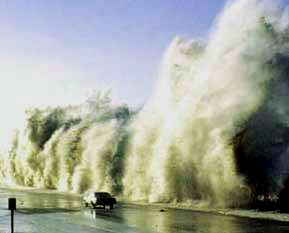A tsunamis power can be really big depending if it was generated somewhere close or far from the place of impact on land. If the tsunami was generated somewhere close if wouldn’t have an impact as powerful as one that was farther away. A tsunamis waves travel at great distances and when the waves start approaching land they start slow down because it is very shallow. When tsunamis waves start to slow down they start to get closer together or to “pile up” and they get to be very tall (Tsunami, Wikipedia).
A tsunami is very powerful as you may already noticed from past tsunamis. A tsunami cannot be seen while it is in deep water, it may only be seen as two feet tall. A tsunami that can be seen as a two feet tall wave in the middle of the ocean that can be a killer tsunami once it hits land maybe over 100 feet tall. (Killer Tsunamis in the Pacific, The Why Files?)(CNN) -- People across Asia are flocking to makeshift morgues seeking lost loved ones after tsunamis swept across the Indian Ocean from Thailand to Somalia, killing more than 26,000 people.(CNN) -- People across Asia are flocking to makeshift morgues seeking lost loved ones after tsunamis swept across the Indian Ocean from Thailand to Somalia, killing more than 26,000 people.
What to do if you think you see tsunamis: first you turn on your radio to see if there is really a tsunamis warning if an earthquake occurs and you are in a coastal aria. Two now if there is a tsunami warning you should move to higher ground as fast as you can. Three never go buy the beech if you do…. Well just don’t think you will make it back off the beach alive.

-
|Tsunami is a Japanese word with the English translation: "harbour wave". In the past, tsunamis have been referred to as "tidal waves" or "seismic sea waves". The term "tidal wave" is misleading; even though a tsunami's impact upon a coastline is dependent upon the tidal level at the time a tsunami strikes, tsunamis are unrelated to the tides. (Tides result from the gravitational influences of the moon, sun, and planets.) The term "seismic sea wave" is also misleading. "Seismic" implies an earthquake-related generation mechanism, but a tsunami can also be caused by a non-seismic event, such as a landslide or meteorite impact.
Tsunamis are also often confused with storm surges, even though they are quite different phenomena. A storm surge is a rapid rise in coastal sea-level caused by a significant meteorological event - these are often associated with tropical cyclones.-
What was the world's largest tsunami?
A tsunami is basically a wave, usually caused by an earthquake or large amounts of debris falling into the water.
Although the Sumatra-Andaman earthquake on December 26, 2004 resulted in perhaps the most devastating tsunami ever recorded, the height of the wave was about 100 feet, far from the largest.
On July 09, 1958 in Lituya Bay, Alaska an earthquake measuring 8.3 on the Richter scale resulted in 40 million cubic meters of rock to fall into the sea.
As the wave swept through Lituya Bay it was forced to rise up, reaching a height of 1,720 feet or 40 feet short of a third of a mile.
Although the hillsides in the bay were devastated, the damage was very localized and as Lituya Bay is very remote, there were very few casualties.
The Lituya Bay tsunami was labeled a mega-tsunami, but it was relatively very small compared to what would happen if the big one hits.
The island of La Palma, in the Canary Islands is in danger of collapsing into the sea and if it does happen it will create a true mega-tsunami.
